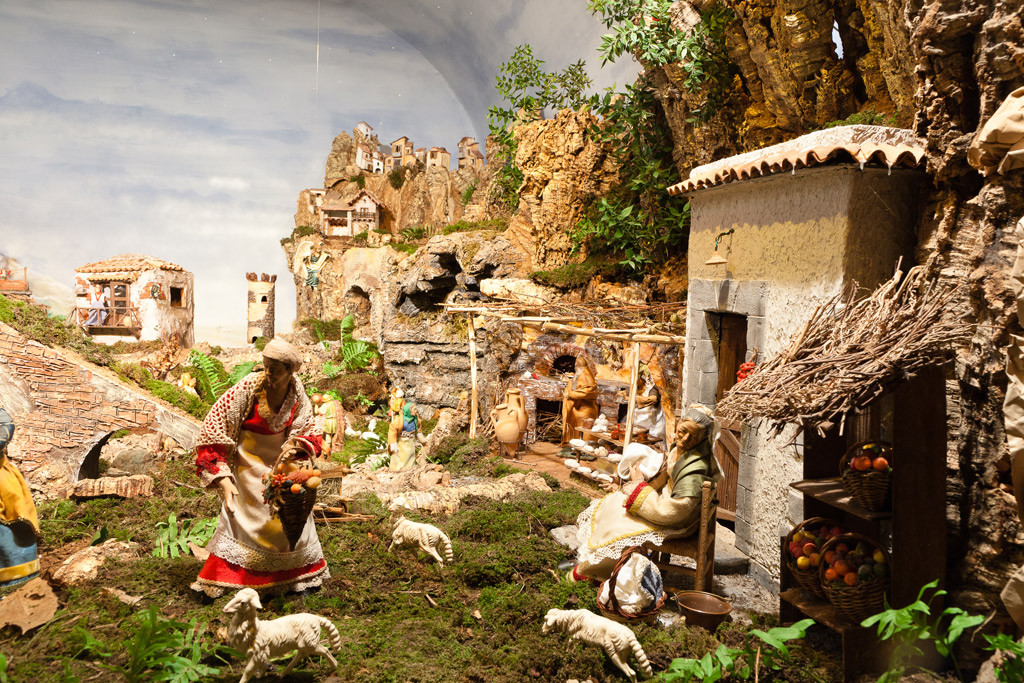“Presepiando”
 ?It is put the manger, bring the hay, are carried away the ox and the ass. It honors therein simplicity, poverty is exalted, people hear the humility and Greccio becomes almost a new Bethlehem?.
?It is put the manger, bring the hay, are carried away the ox and the ass. It honors therein simplicity, poverty is exalted, people hear the humility and Greccio becomes almost a new Bethlehem?.
Therefore, Tommaso from Celano, chronicler of the life of St. Francis, describes the first living representation of the Nativity in 1223 that the Saint realized in Greccio, in the province of Rieti. Since that date, the kind of symbolism was widely understood at all levels, especially within families for which the representation of the birth of Jesus, such as figurines and items taken from the wild. It is an essential ritual, which reached its peak in the eighteenth century, when raised the great traditions of crib, and there was the impressive development of the cribs sculpted. Especially in Naples where the art of pottery with its statues covered with garments of fine fabrics and glittering jewelry authentic, became a real school and cradle of the spread of the crib.
Even today, after centuries, and despite the many ?distractions? of life, the Italian tradition of the crib has not changed, especially in the south where the fervor of the Neapolitan cribs lives wherever they prepare a crib, especially in the family, where it is considered always an affectionate play. Even on the islands of Ischia and Procida there are fortunately, growing groups and associations formed mainly by young ?lovers? of the Nativity that repeat the ritual every year. In early November, and even before, with sacrifice and commitment, they begin the construction of cribs managing to merge the religious spirit and artistic talent in a magnificent work where the poetry of the story is a hymn to life. In all municipalities of the island of Ischia, in homes and churches, particularly in Forio and in the village of Ischia Ponte, undoubtedly the leader and founder regarding crib routes are set up in doorways of buildings plastics depictions with large scenes of the birth of Jesus of exquisite workmanship. The scope and the cultural legacy of the Neapolitan crib reside in the realism of its representations and in the beauty of various characters among which there are, in addition to nativity scene:
the three kings: the nobles of the crib on the back of their three horses in white, red and black, which represent the Christian tradition. They moved from the east, the starting point of the sun, following the night journey of the star that ends there where it connects with the birth of the new baby sun.
The washerwoman: deriving from medieval representations and iconography of Eastern Christian extra liturgical traditions - almost a synonym for midwife who visited the Madonna while giving birth according to the version of some apocryphal Gospels - that after washing the baby stretches to dry the clothes of childbirth, whose candor is impressive for a comparison with the virginity of Mary.
The gypsy: a prophetic character tied to sibyls-prophets that in medieval mystery plays taking primary role. To the Cumaean Sibyl is traditionally attributed a Christmas legend. She had predicted the birth of the Redeemer, deceiving of being herself the virgin who would give birth. Only when she heard the angels announce the birth of Christ, she realized her sin of presumption.
The anglers and the hunter express the oldest activities with which man assured means of subsistence.
The vendors (greengrocer, vintner, butcher, baker, grinder etc.) although in certain trades there was an adversarial anachronism, it is likely to interpret the work activities with calendar period and the personification of the months.
Benin: the shepherd-sleeping boy loved by kids that always occupies a prominent place. He is a character of primary importance, expression of wonder through a dreamlike journey, blinded by the revelation and the light of the cave. He opens his mouth to shout the mute sound of wonder at the sight of the wonderful.
The source is relevant to the figure of the Madonna that, according to various traditions, would have received the Annunciation while drawing water at the source.
The inn alludes to the journey of Joseph and Mary in search of accommodation. ?While they were there, the days were completed for her to give birth. And she gave birth to her firstborn son; and she wrapped Him in cloths, and laid Him in a manger, because there was no room for them in the inn?
? Gospel of Luke ?
Even the island of Procida, small chest of colors and scents, crib inside the crib, has a tradition of considerable importance.
Groups of young people gathered in an association, ?I giovani dei misteri?, deeply rooted in the social and cultural fabric of the island include cribs of valuable inviting many visitors to a kind of crib tour that starts from the village of Terra Murata. It goes through the church of San Giacomo where is set up a real crib exhibition, to the church of the Congregation of Turchini, at the Shrine of St. Joseph in Chiaiolella, to the live nativity of Community Parish of Santa Maria delle Grazie and San Leonardo and the church of Our Madonna della Libera.
The crib for excellence, a masterpiece of Neapolitan eighteenth-century, is kept in the Abbey of San Michele Arcangelo in Terra Murata. On permanent display, it is mainly composed of pastors of the Neapolitan school made in the eighteenth century, in wood and terracotta wearing typical costumes of the provinces of the Kingdom of Naples.
The tradition of the crib, then, is alive and kicking and should be further enhanced and encouraged and passed on to new generations in the belief that it helps to recover the affection towards our culture and strengthen our identity and helps to facilitate, why not, interreligious dialogue and ministry in a multiracial and multicultural society like ours.
Then...to put it in Eduardo De Filippo?s way: ?te piace o? presepio?? (?Do you like the crib??)
Yes, I do! Because it is the true symbol of love, of family, of house and those who live and observe with spirit plunging into the concrete reality of the nativity imagining the smell of straw, the cry of the Child Jesus and the message that it rises.










